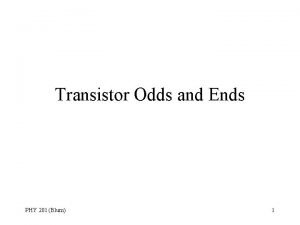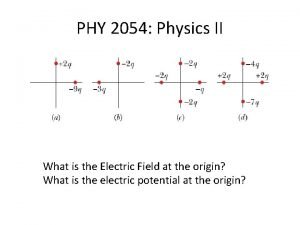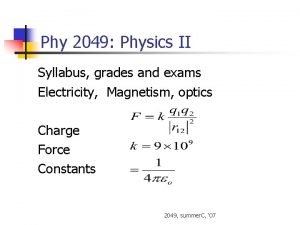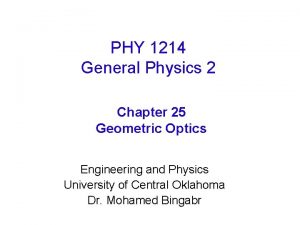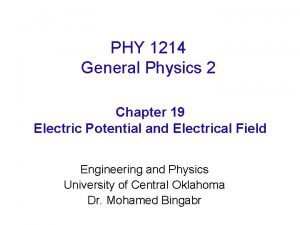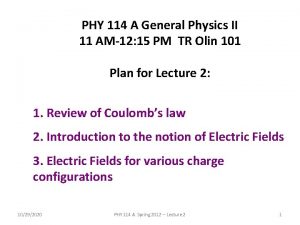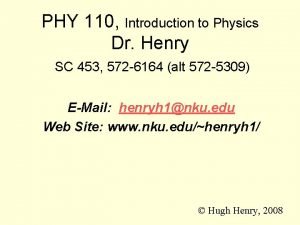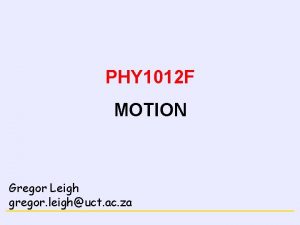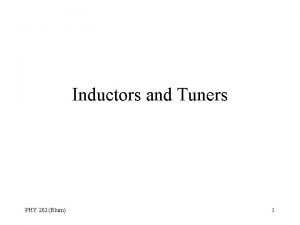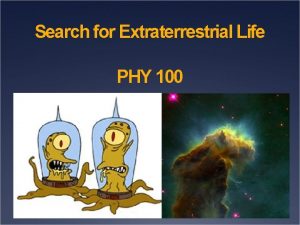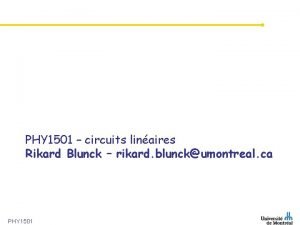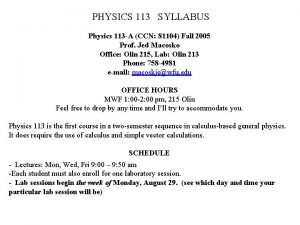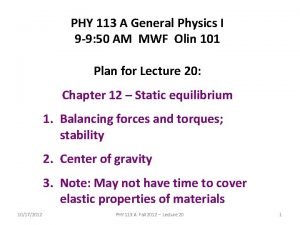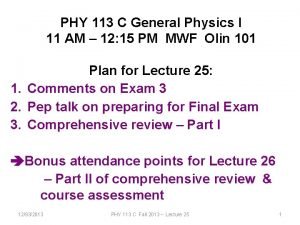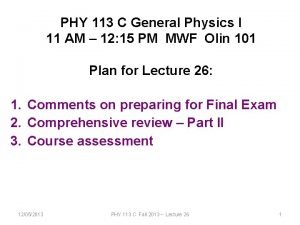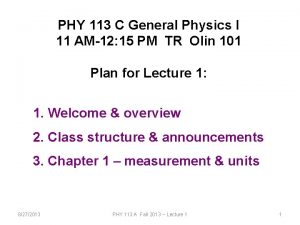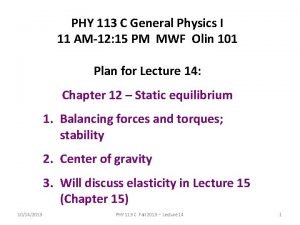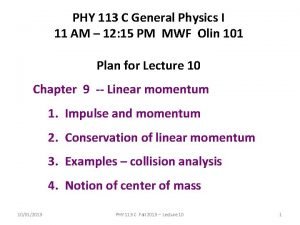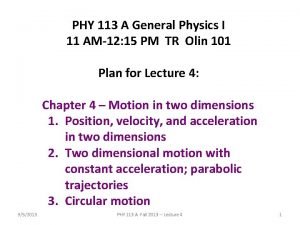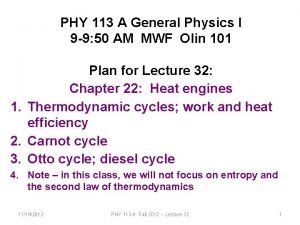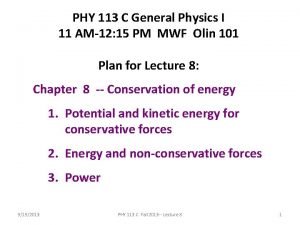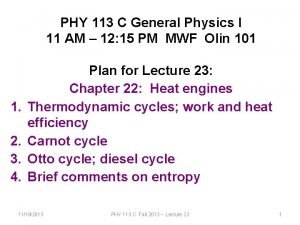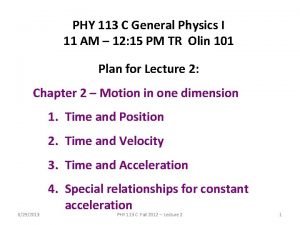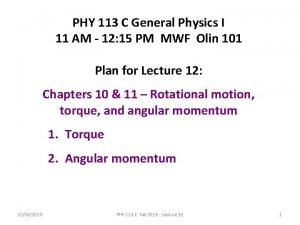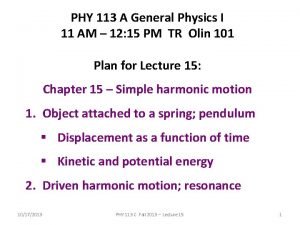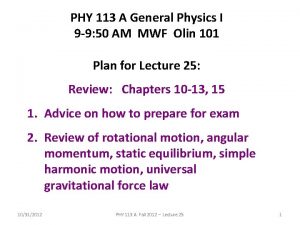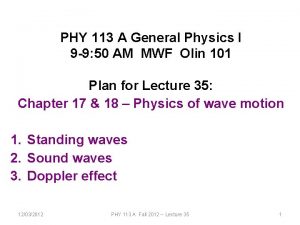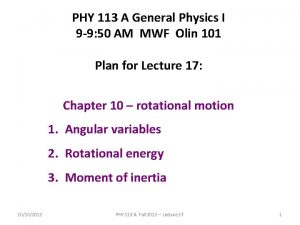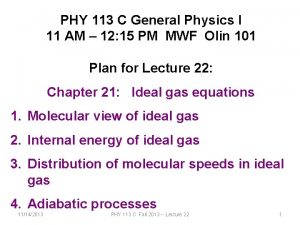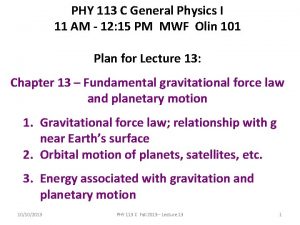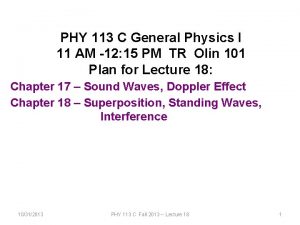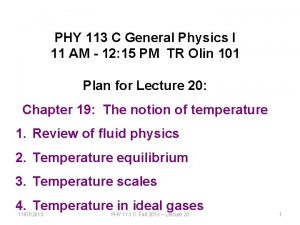PHY 113 A General Physics I 9 9
























- Slides: 24

PHY 113 A General Physics I 9 -9: 50 AM MWF Olin 101 Plan for Lecture 21: Chapter 15 – Simple harmonic motion 1. Object attached to a spring § Displacement as a function of time § Kinetic and potential energy 2. Pendulum motion 10/22/2012 PHY 113 A Fall 2012 -- Lecture 21 1

10/22/2012 PHY 113 A Fall 2012 -- Lecture 21 2

iclicker exercise: Why did your textbook develop a whole chapter on oscillatory motion? A. Because the authors like to torture students. B. Because it is different from Newton’s laws and needs many pages to explain. C. Because it is an example of Newton’s laws and needs many pages to explain. iclicker exercise: Simple harmonic motion has a characteristic time period T. What determines T? A. The characteristics of the physical system. B. The initial displacements or velocities. C. It is not possible to know T. 10/22/2012 PHY 113 A Fall 2012 -- Lecture 21 3

Behavior of materials: Hooke’s law Fs = -k(x-x 0) Young’s modulus x 0 =0 10/22/2012 PHY 113 A Fall 2012 -- Lecture 21 4

Microscopic picture of material with springs representing bonds between atoms Measurement of elastic response: k 10/22/2012 PHY 113 A Fall 2012 -- Lecture 21 5

Potential energy associated with Hooke’s law: Form of Hooke’s law for ideal system: Us = ½ k x 2 Us (J) Fs (N) Fs = -kx x x Us = ½ k (x-1)2 U (J) General potential energy curve: U(x) x 10/22/2012 PHY 113 A Fall 2012 -- Lecture 21 6

In addition to the spring-mass system, Hooke’s law approximates many physical systems near equilibrium. 10/22/2012 PHY 113 A Fall 2012 -- Lecture 21 7

Motion associated with Hooke’s law forces Newton’s second law: F = -k x = m a “second-order” linear differential equation 10/22/2012 PHY 113 A Fall 2012 -- Lecture 21 8

How to solve a second order linear differential equation: Earlier example – constant force F 0 acceleration a 0 x(t) = x 0 +v 0 t + ½ a 0 t 2 2 constants (initial values) 10/22/2012 PHY 113 A Fall 2012 -- Lecture 21 9

Hooke’s law motion: Forms of solution: where: 2 constants (initial values) 10/22/2012 PHY 113 A Fall 2012 -- Lecture 21 10

Verification: Differential relations: Therefore: 10/22/2012 PHY 113 A Fall 2012 -- Lecture 21 11

10/22/2012 PHY 113 A Fall 2012 -- Lecture 21 12

iclicker exercise: Which of the following other possible guesses would provide a solution to Newton’s law for the massspring system: 10/22/2012 PHY 113 A Fall 2012 -- Lecture 21 13

10/22/2012 PHY 113 A Fall 2012 -- Lecture 21 14

10/22/2012 PHY 113 A Fall 2012 -- Lecture 21 15

“Simple harmonic motion” in practice A block with a mass of 0. 2 kg is connected to a light spring for which the force constant is 5 N/m and is free to oscillate on a horizontal, frictionless surface. The block is displaced 0. 05 m from equilibrium and released from rest. Find its subsequent motion. w= x(t)= A cos (wt+f) v(t)=-Awsin (wt+f) x(0) = A cos (f) = 0. 05 m v(0)=-Awsin (f) = 0 m/s f = 0 and A = 0. 05 m 10/22/2012 PHY 113 A Fall 2012 -- Lecture 21 16

iclicker exercise: A certain mass m on a spring oscillates with a characteristic frequency of 2 cycles per second. Which of the following changes to the mass would increase the frequency to 4 cycles per second? (a) 2 m 10/22/2012 (b) 4 m (c) m/2 (d) m/4 PHY 113 A Fall 2012 -- Lecture 21 17

Summary -Simple harmonic motion: Conveniently evaluated in radians Note that: 10/22/2012 Constants PHY 113 A Fall 2012 -- Lecture 21 18

Energy associated with simple harmonic motion 10/22/2012 PHY 113 A Fall 2012 -- Lecture 21 19

Energy associated with simple harmonic motion 10/22/2012 PHY 113 A Fall 2012 -- Lecture 21 20

Energy diagram: U(x)=1/2 k x 2 E=1/2 k A 2 K x 10/22/2012 PHY 113 A Fall 2012 -- Lecture 21 A 21

Effects of gravity on spring motion x=0 10/22/2012 PHY 113 A Fall 2012 -- Lecture 21 22

Simple harmonic motion for a pendulum: L Q 10/22/2012 Approximation for small Q: PHY 113 A Fall 2012 -- Lecture 21 23

Pendulum example: Suppose L=2 m, what is the period of the pendulum? L Q 10/22/2012 PHY 113 A Fall 2012 -- Lecture 21 24
 Phy 113 past questions and answers
Phy 113 past questions and answers Phy 131 past papers
Phy 131 past papers Pa msu
Pa msu Great orthogonality theorem proof
Great orthogonality theorem proof Rotational statics
Rotational statics Phy theorem
Phy theorem Phy 131 asu
Phy 131 asu Ddr phy architecture
Ddr phy architecture Phy 205
Phy 205 Accommodation eye
Accommodation eye Phy 2049
Phy 2049 Physics 2
Physics 2 Phy
Phy Phy
Phy Atm basics
Atm basics Phy
Phy Phy 2049
Phy 2049 Real image
Real image Phy 1214
Phy 1214 Phy
Phy Phy 110
Phy 110 Phy
Phy Felix connects a wire coil to an ammeter
Felix connects a wire coil to an ammeter Life phy
Life phy Phy1501
Phy1501













